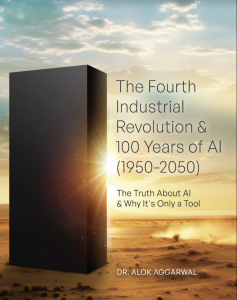
Frontiers of Quantum Computing and Beyond Explored in New Book from Alok Aggarwal
With the expected demise of Moore’s Law, Quantum Computing is often touted as the basis for the next universal computing platform
SAN JOSE, CALIFORNIA, USA, April 4, 2024 /EINPresswire.com/ -- Alok Aggarwal’s new book, "The Fourth Industrial Revolution & 100 Years of AI (1950-2050),” explores the potential landscape of the next generation of computing infrastructure. One of the most profound effects in improving AI algorithms can be attributed to Moore’s Law - an empirical observation made by Gordon Moore - which states, “the computational power of semiconductors would double every two years.” So far, Moore’s law that started around 1965 has worked well but by 2030, it would be no longer viable.The book’s fifteenth chapter, titled “Future of Computing,” explores Quantum Computing, which researchers have been working on since 1980. Quantum Computing uses three universal laws from Quantum Physics that are related to entanglement, superposition, and measurement. However, these laws are counterintuitive. For example, Einstein dubbed entanglement as "spooky action at a distance".
Other key takeaways from this chapter include:
• Quantum Computing will take at least fifteen years before it can be commercialized: The discovery of Quantum Physics in 1905 laid the scientific foundations for Quantum Computing, which was developed by Paul Benioff seventy-five years later. Despite tall claims made by several firms, since Quantum Computing is still nascent and counterintuitive, its extensive commercialization may not be possible for the next fifteen years (i.e., 58 years after its introduction).
• From a theoretical perspective, Quantum Computing appears extremely promising: For example, using a Quantum Computing algorithm, the time to search through one trillion news articles can be reduced by a factor of almost a million as compared to classical computing algorithms.
• Quantum Computing may disrupt classical cyber-security algorithms: Most public key cyber-security systems rely on the fact that currently it is computationally almost infeasible for classical computers to determine prime numbers that are factors of a given large integer, e.g., a number that has 256 or more digits. However, at least theoretically, Quantum Computing algorithms can factor large numbers efficiently, thereby allowing Quantum Computers to break many contemporary cryptographic systems.
• Optical computing and graphene-based computing also look promising: Since optics-based fiber networks are already being used for electronic communication, optical computing seems further along and recent advances in building microprocessors using graphene-based nanotubes is also encouraging. Other nascent technologies include biological computing and neuromorphic computing, but they need more research before they are deemed viable.
• Building and using specialized processors for training AI algorithms: To avoid the fallout from the demise of Moore’s law, innovators are building specialized processing systems for training AI models. These include Application Specific Integrated Circuits (ASICs) such as Field-Programmable Gate Arrays (FPGAs) and Tensor Processing Units (TPUs). However, the initial cost for programming such ASICs and FPGAs is high and sometimes prohibitive.
• Building and using smaller specialized processors for predictions and inferencing: Inventors are also building much smaller processors so that trained AI models can be sent to these processors, which they can use to make predictions or inferences. Indeed, such processors can be used by cameras, smartphones, and other sensors and devices so that they do not have to transmit vast amount of incoming data to central servers, and they also have lower constraints with respect to computation, communication, heat, and electricity.
Overall, the book, “The Fourth Industrial Revolution & 100 Years of AI (1950-2050)” provides a concise yet comprehensive exploration of AI, covering its origins, evolutionary trajectory, and its potential ubiquity during the next 27 years. Beginning with an introduction to the fundamental concepts of AI, subsequent chapters delve into its transformative journey with an in-depth analysis of achievements of AI, with a special focus on the potential for job loss and gain. The latter portions of the book examine the limitations of AI, the pivotal role of data in enabling accurate AI systems, and the concept of "good" AI systems. This book is now available in bookstores and online retailers in Kindle, paperback, and hard cover formats.
About the Author and Scry AI: Dr. Aggarwal is the founder, CEO, and Chief Data Scientist of Scry AI, which provides innovative AI-based products, solutions, and services to enterprises across the globe. Before starting Scry AI, he co-founded Evalueserve (www.evalueserve.com) which provides research and analytics services worldwide. He received his Ph. D. from Johns Hopkins University and worked at IBM’s T. J. Watson Research Center during 1984 and 2000. He has written more than 120 research articles and has been granted eight patents.
Scry AI is a research and development company that uses AI and Data Science to help its clients in solving complex and extremely laborious problems. Scry AI has developed more than 60 proprietary AI-based models and algorithms which constitute its CognitiveBricks platform of innovative business solutions. Scry AI’s family of enterprise solutions include: Collatio (an Intelligent Document Processing factory with unparalleled accuracy for reconciling unstructured and structured data), Anomalia (for detecting anomalies and potential fraud), Concentio (for providing actionable insights using Internet of Things’ data), Vigilo (for predicting operational and marketing risks), and Data Flow Mapping (for extracting data lineage as data flows through disparate systems). For more information, please visit: www.scryai.com
Alok Aggarwal
Scry AI, Inc.
+1 9149804717
email us here
Visit us on social media:
Facebook
Twitter
LinkedIn
Instagram
YouTube
EIN Presswire does not exercise editorial control over third-party content provided, uploaded, published, or distributed by users of EIN Presswire. We are a distributor, not a publisher, of 3rd party content. Such content may contain the views, opinions, statements, offers, and other material of the respective users, suppliers, participants, or authors.


